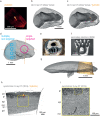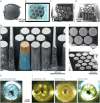Femtosecond laser preparation of resin embedded samples for correlative microscopy workflows in life sciences
- PMID: 37151852
- PMCID: PMC10162021
- DOI: 10.1063/5.0142405
Femtosecond laser preparation of resin embedded samples for correlative microscopy workflows in life sciences
Abstract
Correlative multimodal imaging is a useful approach to investigate complex structural relations in life sciences across multiple scales. For these experiments, sample preparation workflows that are compatible with multiple imaging techniques must be established. In one such implementation, a fluorescently labeled region of interest in a biological soft tissue sample can be imaged with light microscopy before staining the specimen with heavy metals, enabling follow-up higher resolution structural imaging at the targeted location, bringing context where it is required. Alternatively, or in addition to fluorescence imaging, other microscopy methods, such as synchrotron x-ray computed tomography with propagation-based phase contrast or serial blockface scanning electron microscopy, might also be applied. When combining imaging techniques across scales, it is common that a volumetric region of interest (ROI) needs to be carved from the total sample volume before high resolution imaging with a subsequent technique can be performed. In these situations, the overall success of the correlative workflow depends on the precise targeting of the ROI and the trimming of the sample down to a suitable dimension and geometry for downstream imaging. Here, we showcase the utility of a femtosecond laser (fs laser) device to prepare microscopic samples (1) of an optimized geometry for synchrotron x-ray tomography as well as (2) for volume electron microscopy applications and compatible with correlative multimodal imaging workflows that link both imaging modalities.
© 2023 Author(s).
Conflict of interest statement
Yes, J.L., A.C.D., R.C., and H.S. are employees of Carl Zeiss Microscopy GmbH, the manufacturer of the femtosecond laser and of the Zeiss Crossbeam FIB-SEM employed and evaluated in this study. The authors have no further relevant interest to disclose.
Figures




References
-
- Barnett R., Mueller S., Hiller S. et al., “ Rapid production of pillar structures on the surface of single crystal CMSX-4 superalloy by femtosecond laser machining,” Opt. Lasers Eng. 127, 105941 (2020).10.1016/j.optlaseng.2019.105941 - DOI
-
- Gu A., Terada M., Stegmann H. et al., in IEEE International Symposium on the Physical and Failure Analysis of Integrated Circuits (IPFA) ( IEEE, 2022), pp. 1–5.
-
- Sugioka K. and Cheng Y., “ Ultrafast lasers—Reliable tools for advanced materials processing,” Light. 3, e149 (2014).10.1038/lsa.2014.30 - DOI
-
- Le Harzic R., Huot N., Audouard E. et al., “ Comparison of heat-affected zones due to nanosecond and femtosecond laser pulses using transmission electronic microscopy,” Appl. Phys. Lett. 80, 3886–3888 (2002).10.1063/1.1481195 - DOI
Grants and funding
LinkOut - more resources
Full Text Sources
